#Capoeira Angola
Explore tagged Tumblr posts
Text
Mestre Caiçara 2011
youtube
View On WordPress
0 notes
Text
Capoeira Angola Nedir?
0 notes
Text

Every week we meet in Mid City Los Angles for Capoeira Classes. This multi-cultural gathering is great for the body, the mind, and the soul. Capoeira is a Martial art that mixes dance, music, sparring and playfulness, all the while creating a heck of a workout. Sign-up to get info on your first FREE class
#capoeira#capoeira near me#capoeira los angeles#capoeira mid city#Mid City Capoeira#Angola LA#Angolala#Capoeira angola#Capoeira 4 all#yoga#Culver City arts district#mid city arts center#mid city artist#mid city community#Culver City community#bjj
1 note
·
View note
Photo

Mockup for Capoeira Art Book - Artwork from book available at
http://www.getoromi.com/store/p78/Capoeira_Roda_001.html#/
#capoeira#in design#ux ui design#art#martial arts#capoeira angola#capoeira brasil#oro mi#director oro#get oromi#painters#illustration#illustrated book#art collecting/sales
0 notes
Text
No ano de 2017 eu tentei compor uma música voltada a capoeira de angola e ficou assim:
A abelha italianaOh, meu Deus! Foi na roça do seu ZéOh, meu Deus! Buscar o polénOh, meu Deus! Pra fazer o seu méOh, meu Deus! A abelha italianaOh, meu Deus! Esperava o seu ZéOh, meu Deus Que sem rezar o ave-mariaOh, meu Deus! Foi colher o seu méOh, meu Deus! A abelha italianaOh, meu Deus! Ferruou o seu ZéOh, meu Deus! Quando viu dona JoanaOh, meu Deus Foi cuidar do seu ZéOh, meu…

View On WordPress
0 notes
Text
Artes Marciais e a Cultura Africana

Continente africano é repleto de surpresas, entre elas, a arte marcial da capoeira. Um gingado único e também fatal. A arte é ensinada de geração em geração e ainda promove a saúde e bem-estar.
A disciplina é fundamental. Estar centrado e focado.
Assim é ensinado.
Isso é África.
1 note
·
View note
Text
Capoeira as art and liberation
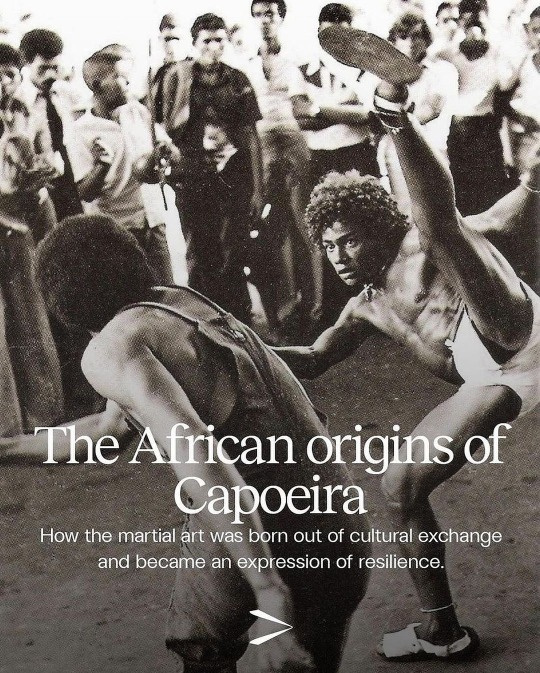
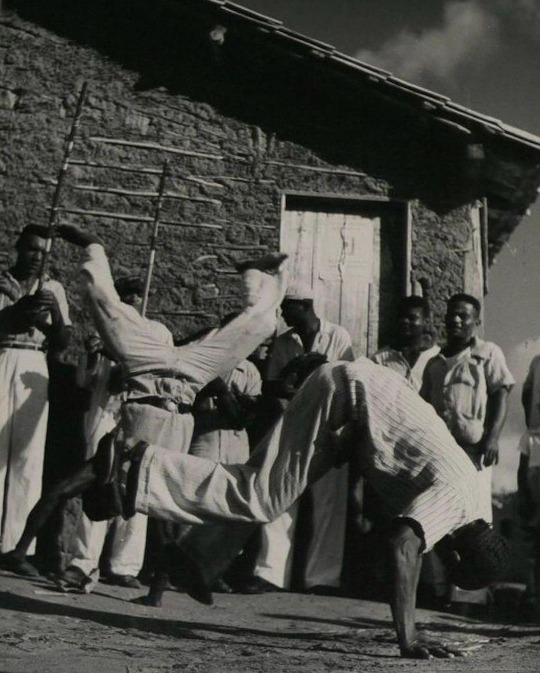
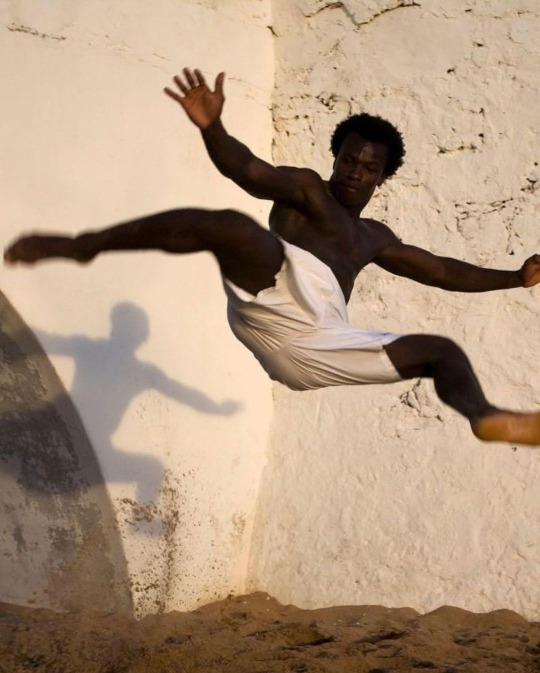

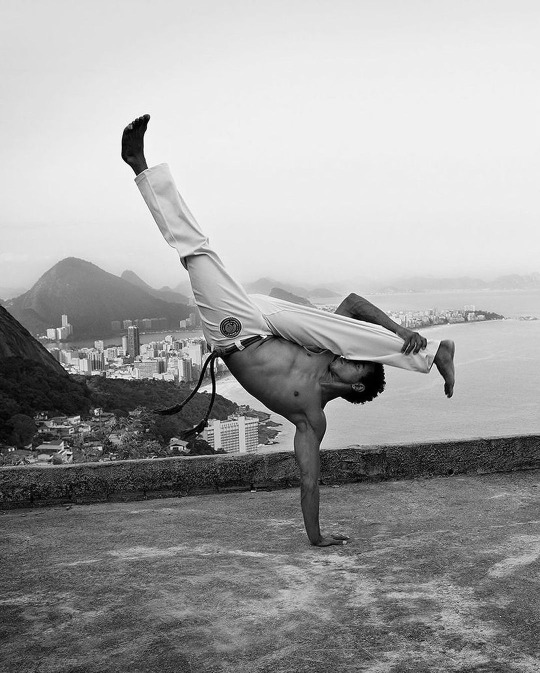
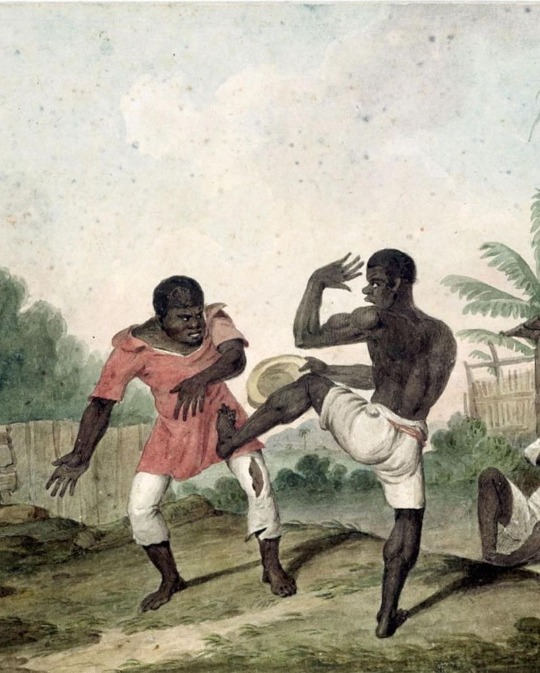
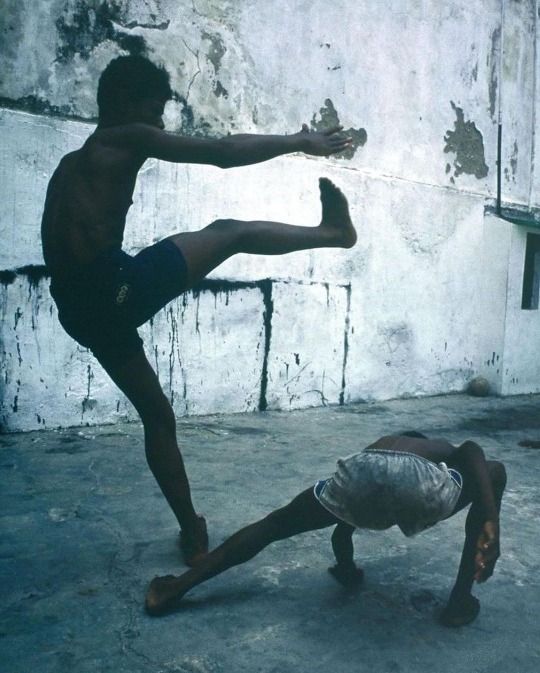
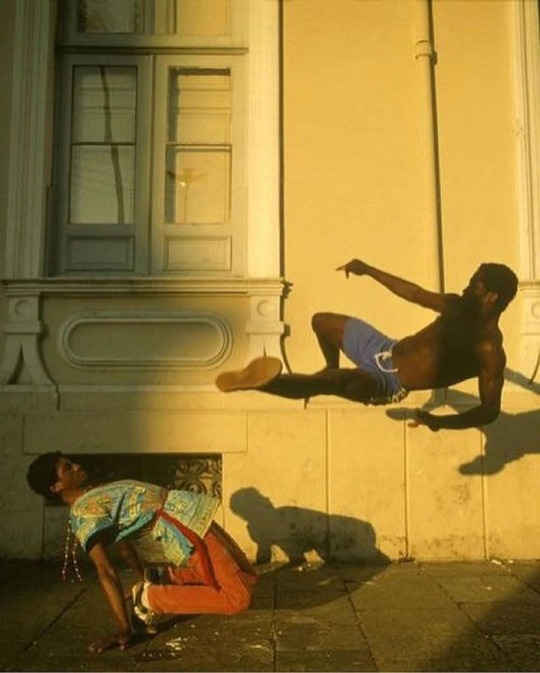
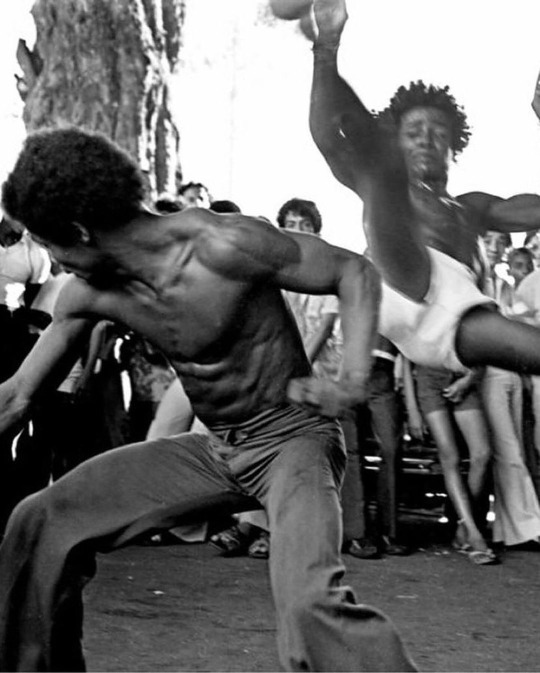

Repost from @moyoafrika
•
#repost• @whatsculture History Class: Tracing the roots of Capoeira. The Afro-Brazilian martial art form incorporates acrobatics, dance, folklore, and music. Two opponents play each other inside a circle (Roda) formed by the other players, who create rhythm for the game by clapping, singing, and playing traditional instruments. It’s the second most popular sport in Brazil and is practiced in different parts of the world today. To understand the significance, we look at how it is a phenomenon born out of migration.
“Capoeira was conceived in Africa and born in Brazil,’’ Mestre Jelon Vieira once said. As a colony of the Portuguese Crown, millions of Africans were shipped and sold in Brazil. There, enslaved Africans shared their cultural traditions, including dances, rituals, and fighting techniques, which eventually evolved into capoeira. Many elements and traditions that would inform capoeira are said to have originated in Angola. At that time, 80% of all enslaved Africans in Rio de Janeiro came from Central West Africa from countries that are now known as Gabon, Angola and both Congos.
People from Angola were prominent among the enslaved Africans who played the game on the streets and squares of Rio de Janeiro, Salvador and other Brazilian port cities at the beginning of the nineteenth century. With many enslaved Africans revolting against slavery, they would soon form communities in villages called quilombos in which they could sustain different expressions of African culture. They used capoeira to defend themselves and resist capture, disguising its martial intent with music, song, and dance.
Capoeira became illegal after the abolition of slavery in 1888. Practitioners were socially ostracised for more 40 years, until the legendary capoeira master, Mestre Bimba, opened the first capoeira school in Bahia in 1932. From there, the martial art would reach all parts of the world. At its core, capoeira is born out of a mix of African and Brazilian indigenous cultures and it represents resistance and resilience 🇧🇷🌍
#moyoafrika #brazil #angola🇦🇴 #africanculture #africanculture #africandiaspora #african
883 notes
·
View notes
Text
N’golo (Engolo): The African Martial Art Dance and its Influence on Capoeira and Diaspora - Pan African Central Core

3 notes
·
View notes
Text

"Taniec Słońca"
Gdzieś na plantancji trzciny cukrowej niewolnicy wyobrazili sobie taniec zamaszyste ruchy ramion, obrotowe kopnięcia spętane kajdanami nogi odzyskują swobodę w rytuale roda śpiew niesie się ponad dachami cukrowni é luta, é dança, é jogo. Capoeira...
Jakże piękne ma imię wyzwolenie: Capoeira! spotęgowane w rustykalny taniec na grobach poległych niewolników, w cukrowni żywi trenują codziennie swe zamachy i kopnięcia wkraczając w zamknięty krąg roda tam, gdzie powietrze przecinają nogi.
Rozmasowane, rozedrgane niewolnicze nogi poświęciły się dźwięcznej drodze o nazwie Capoeira Orkiestra bateria już szykuje roda zaraz rozpocznie się ekstatyczny taniec którego wyrazem są akrobatyczne kopnięcia wsiąka pot w ziemię, niczym krew na terenie starej cukrowni.
Wnikając zaś w gleby brazylijskiej cukrowni pot spotyka krew, a zczerniałe ręce nogi tam wzburza się matka ziemia, przekazując dar obrotowego kopnięcia synom i córkom uprowadzonym z Angoli, dając sen Capoeira ni to walkę, ni to taniec zamkniętą przy dźwiękach berimbau w roda.
Niewolnicy tworzą koło, klaszczą, grają w roda na pamiątkę porwanych przodków w brazylijskiej cukrowni rozpościerają ciała układając je w taniec a rytm sam niesie nogi Angola Capoeira! krzyczą wyprowadzając swoje kopnięcia.
W stronę Słońca niosą się niewolnicze kopnięcia zaciskając coraz ciaśniej krąg roda w frywolnej walce Capoeira gdzieś późnym popołudniem w starej cukrowni gdy krzyżują się muskularne nogi i ramiona wtórując im tworzą wyzwoleńczy taniec.
Tak więc to ten taniec, wprzęgnięty w kopnięcia rysując linię nogi, wkraczając w roda upamiętnia śmierć w cukrowni; a imię nosi Capoeira! Olga Rembielińska
#capoeira#olga rembielińska#poezja#po polsku#wiersze#poezja polska#poezja wlasna#poezja współczesna#wiersz
3 notes
·
View notes
Note
Can you tell us more about Capoeira? And what makes southern Brazilian barbecue so good? 🥰
Of course! 🖤 I remember learning that Capoeira was actually a way for slaves to fight between each other without drawing the attention of their masters, as it could easily be mistaken with just dancing. But I'm not sure if this is just a legend, or if it's actually true!
I do know that it was forbidden and considered criminal in the 19th century, though. For what I've read, it originated in Angola and with time, in Brazil, people started implementing different moves, so it's very diversified now. It's actually really hard to tell if it's dancing or fighting! 🤣 cause there's usually music too. There's many videos on YouTube if you're interested, you're gonna understand what I mean.
And in regards to southern barbecue, I guess we just eat way more meat than in other areas? In São Paulo, barbecue is usually accompanied by other things, while in the states of the south, it's mostly just about red mean hahaha. And we also have the fame or liking rare meat. (There's a whole fight in Brazil about ways to prepare red meat, and it usually includes the rare meat team being accused of eating raw meat and the well done team being accused of eating coal 👀).
#asks#lovely moots 💕#i wish i knew more about my own culture hehehe#but also brazilians out there feel free to add to this
5 notes
·
View notes
Text
HORSES NEIGHED AND FIRES CRACKLED as Queen Tamar of Georgia walked among her troops on the eve of battle in July 1203. Her enemies outnumbered her soldiers nearly two to one. Still, the queen did not waver as she spoke words of courage to the assembled army. In a show of humility, she stood before them barefoot while wearing lavish garments full of religious symbolism to inspire a righteous bravery in all who saw her. As she finished her rousing speech, hardy, battle-worn soldiers stood, raised their spears, and shouted, “To our king!” The next day, the Georgian army decimated their foe.
In the late 12th and early 13th centuries, Tamar the Great ushered in Georgia’s golden age. She expanded borders, oversaw massive architectural projects, and helped define the kingdom’s unique identity at the crossroads of East and West. She sat on war councils and, as one chronicler wrote, “took counsel with them, not like a helpless person, or a woman, and did not neglect the dictates of reason.”
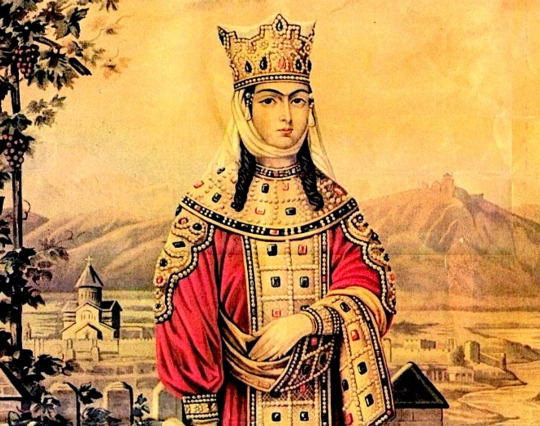
As father/daughter historians Jonathan and Emily Jordan demonstrate in their book, War Queens: Extraordinary Women Who Ruled the Battlefield, Tamar was far from history’s only warrior queen. The pair recently launched a new podcast with Diversion Audio (also called War Queens) where they dig into all the twists and bloody turns of Tamar’s story alongside other battle-hardened queens.
Atlas Obscura sat down with Emily Jordan to talk about why Italian philosopher Niccolò Machiavelli had it out for her favorite fortress-seizing countess, an African queen who went toe-to-toe with Portuguese enslavers, and why so often these women’s stories go overlooked.
. . .
Who is your favorite person you highlight in the book or on the podcast? And why?
I think in terms of courage, I’d have to say Caterina Sforza. She’s really just an incredible Renaissance woman. She learned all about medicine, botany. She got to interact with Botticelli and Da Vinci. She went to people during times of plague with medicines that she created and studied. My favorite story about her is when her husband’s political interests were compromised when the pope died. Her husband was a paranoid, vicious man, but his family member was the pope. And when the pope passed away, that got Caterina thinking, “We may not be confirmed as the ruler of this city, of Imola.”
So she rides down to Rome, while pregnant, in her early twenties, and she takes hold of this great fortress, Castel Sant’Angelo. The cardinals have to cross in front of the castle on this big bridge to get over to Vatican City. So she points the cannons right at them and says. “Rome, hold up. Stop. I’m in charge.” She stops all of Rome and stops the cardinals from electing a new pope until they confirm her and her husband’s titles. The fact that she did this in her early twenties while pregnant is insane to me.
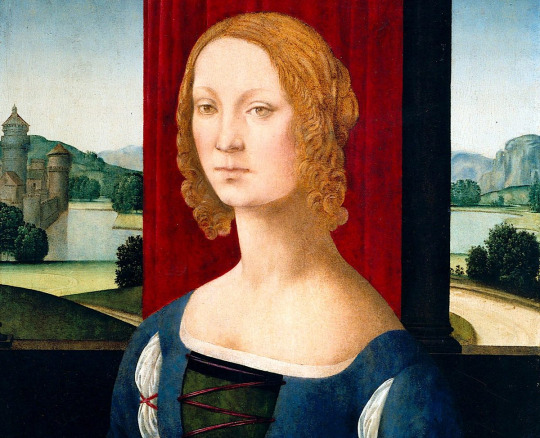
Did any of these war queens have experience in battle?
Queen Njinga Mbandi of Ndongo-Matamba [two African kingdoms located in present-day Angola] is by far the most physically capable of all the women we write about. Very few of our women really had a lot of hand-to-hand combat experience; Caterina Sforza had a little bit. But Njinga [sometimes spelled “Nzinga”] would charge into battle with her people. She lived during the 17th century and was the leader of her tribe. She had an older brother who was in power before her, but she was a better hand-to-hand combat fighter, leader, and diplomat, so she kind of takes charge. She was this amazing chameleon and takes on different types of cultures in order to unite her people.
She was trained to do this martial art. It’s linked to the Brazilian art of capoeira where you almost do dances as exercises, jumping side to side out of the way of arrows and bullets. Certain scholars even claim that a part of the art, called ginga [pronounced and sometimes spelled “jinga”], is named after her. Their main weapon was a form of battle axe, and she was really well-trained with that axe as well.
5 notes
·
View notes
Photo

Flyer Design for Capoeira Workshops in Chico, CA. www.instagram.com/capoeira4all
0 notes
Video
youtube
Capoeira Ladainha: Mestre Jogo de Dentro - Capoeira de Angola + Lyrics/L...
0 notes
Text
Mestre Moa do Katende — Capoeira Angola Sheffield
1 note
·
View note
Text
O Centro de Ciências da Saúde e do Esporte (Cefid), da Universidade do Estado de Santa Catarina (Udesc), está com vagas abertas para aulas gratuitas de capoeira nos bairros Coqueiros e Ratones, em Florianópolis, por meio do projeto de extensão Ubuntu Capoeirar, que é ligado ao programa de extensão Lazer e Saúde, do Laboratório de Pesquisa em Lazer e Atividade Física (Laplaf). As atividades são desenvolvidas em parceria com a Associação de Moradores de Ratones (Amora) e a Associação Cultural Catarinense Capoeira Angola Palmares (Acccap), com supervisão do mestre Polegar. Tanto integrantes da comunidade acadêmica da Udesc Cefid, quanto a população em geral podem participar das aulas. As atividades do Bairro Coqueiros ocorrem em dois locais da Udesc Cefid, na Rua Pascoal Simone, nº 358: na Sala de Artes Marciais, nas segundas e quartas-feiras, das 12h30 às 14h; e no Ginásio 2, nas sextas-feiras, também das 12h30 às 14h. As inscrições podem ser feitas com o Laplaf pelo telefone (48) 3664-8629 e pelo Instagram do laboratório. Já no Norte da Ilha de Santa Catarina, as aulas são na sede da Amora, na Estrada Intendente Antônio Damasco, nº 3.790, nas terças e quintas-feiras, às 17h30 para crianças e às 18h30 para adultos. Quem estiver interessado pode se inscrever via WhatsApp, no número (48) 99696-2976, e pelo Instagram da Capoeira Angola Palmares Florianópolis – Mestre Polegar. “As atividades já estão ocorrendo, e convidamos estudantes, servidores e população a participar”, destaca a coordenadora do Laplaf, professora Alcyane Marinho. Segundo ela, outras ações de capoeira serão realizadas neste semestre também. Em setembro, por exemplo, haverá a vivência de capoeira com o professor Moçamba (Cabo Verde), nos dias 11 e 13; a palestra “Fundamentos da capoeira angola com Mestre Nô (Salvador)”, no dia 20; e o Encontro Anual Capoeira Angola Palmares Florianópolis 2024, com a formatura dos alunos dos projetos de extensão, no dia 21. Mais informações Mais informações podem ser obtidas pelo e-mail [email protected]. Novidades da Udesc Cefid também estão disponíveis nas mídias sociais do centro: Instagram, Facebook, WhatsApp e X (antigo Twitter). Assessoria de Comunicação da Udesc CefidJornalista Rodrigo Brüning SchmittE-mail: [email protected]: (48) 98801-7729Telefone: (48) 3664-8637 Fonte: Governo SC
0 notes
Text

roda de capoeira angola na festa do boi no morro do querosene
0 notes